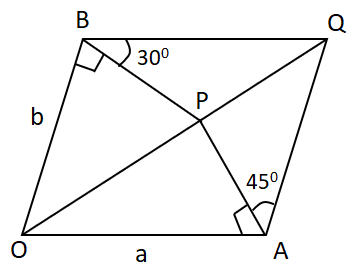
Two straight roads OA and OB intersect at O. A tower is situated within the angles formed by them and subtends angles of \[{45^0}\]and \[{30^0}\]at the points A and B where the roads are nearest to it. If OA=a and OB=b, then the height of the tower is
A.\[\dfrac{{\sqrt {({a^2} + {b^2})} }}{2}\]
B.\[\sqrt {({a^2} + {b^2})} \]
C. \[\dfrac{{\sqrt {({a^2} - {b^2})} }}{2}\]
D. \[\sqrt {({a^2} - {b^2})} \]
Answer
217.8k+ views
Hint: By using Pythagorean theorem which gives the relation between hypotenuse, perpendicular and base of a right angled triangle we can find the height of the tower. Also here apply trigonometric identities.
Formula used: In right angled triangle, by Pythagorean theorem
\[{H^2} = {P^2} + {B^2}\]
Where H is hypotenuse
P is perpendicular
B is base
Complete step-by-step solution: Given OA = a, OB = b

Image: A tower is situated within the angles of \[{45^0}\]and \[{30^0}\]at the points A and B
Let PQ be the tower of height h and PA, PB be the perpendicular from top of the tower P upon OA & OB respectively.
In figure \[\angle PBQ = {30^o}{\rm{ and }}\angle {\rm{PAQ = 4}}{{\rm{5}}^0}\]
In
\[\begin{array}{l}\cot {45^0} = \dfrac{{base}}{{perpendicular}}\\{\rm{ 1 = }}\dfrac{{PA}}{h}{\rm{ (cot4}}{{\rm{5}}^0} = 1)\end{array}\]
PA = h
In
\[\begin{array}{l}\cot {30^0} = \dfrac{{base}}{{perpendicular}}\\{\rm{ }}\sqrt 3 {\rm{ = }}\dfrac{{PB}}{h}{\rm{ (cot3}}{{\rm{0}}^0} = \sqrt 3 )\end{array}\]
PB =\[\sqrt 3 {\rm{ h}}\]
Now In\[\Delta OPA\], by Pythagorean theorem
\[{H^2} = {P^2} + {B^2}\]
\[O{P^2} = P{A^2} + O{A^2} = P{B^2} + O{B^2}\]
Substituting all the values, we get
$h^2 + a^2 = 3h^2 + b^2$
$2h^2 = a^2 – b^2$
h = \[\dfrac{{\sqrt {({a^2} - {b^2})} }}{2}\]
Therefore the height of the tower is\[\dfrac{{\sqrt {({a^2} - {b^2})} }}{2}\]
Hence option C is the correct answer.
Note:If two right angled triangles form with the same perpendicular side, then we can use Pythagoras theorem for both triangles and equate them to get the same perpendicular side. In mathematics, the Pythagorean theorem or also known as Pythagoras theorem is a fundamental relation in geometry among the three sides of a right-angled triangle.
Formula used: In right angled triangle, by Pythagorean theorem
\[{H^2} = {P^2} + {B^2}\]
Where H is hypotenuse
P is perpendicular
B is base
Complete step-by-step solution: Given OA = a, OB = b

Image: A tower is situated within the angles of \[{45^0}\]and \[{30^0}\]at the points A and B
Let PQ be the tower of height h and PA, PB be the perpendicular from top of the tower P upon OA & OB respectively.
In figure \[\angle PBQ = {30^o}{\rm{ and }}\angle {\rm{PAQ = 4}}{{\rm{5}}^0}\]
In
\[\begin{array}{l}\cot {45^0} = \dfrac{{base}}{{perpendicular}}\\{\rm{ 1 = }}\dfrac{{PA}}{h}{\rm{ (cot4}}{{\rm{5}}^0} = 1)\end{array}\]
PA = h
In
\[\begin{array}{l}\cot {30^0} = \dfrac{{base}}{{perpendicular}}\\{\rm{ }}\sqrt 3 {\rm{ = }}\dfrac{{PB}}{h}{\rm{ (cot3}}{{\rm{0}}^0} = \sqrt 3 )\end{array}\]
PB =\[\sqrt 3 {\rm{ h}}\]
Now In\[\Delta OPA\], by Pythagorean theorem
\[{H^2} = {P^2} + {B^2}\]
\[O{P^2} = P{A^2} + O{A^2} = P{B^2} + O{B^2}\]
Substituting all the values, we get
$h^2 + a^2 = 3h^2 + b^2$
$2h^2 = a^2 – b^2$
h = \[\dfrac{{\sqrt {({a^2} - {b^2})} }}{2}\]
Therefore the height of the tower is\[\dfrac{{\sqrt {({a^2} - {b^2})} }}{2}\]
Hence option C is the correct answer.
Note:If two right angled triangles form with the same perpendicular side, then we can use Pythagoras theorem for both triangles and equate them to get the same perpendicular side. In mathematics, the Pythagorean theorem or also known as Pythagoras theorem is a fundamental relation in geometry among the three sides of a right-angled triangle.
Recently Updated Pages
Area vs Volume: Key Differences Explained for Students

Mutually Exclusive vs Independent Events: Key Differences Explained

Direct and Inverse Variations Explained Simply

Distance Between Two Parallel Lines: Formula & Easy Guide

Eigenvectors of a Matrix Explained: Step-by-Step Guide

Surface Area and Volume Examples for Students

Trending doubts
JEE Main 2026: Application Form Open, Exam Dates, Syllabus, Eligibility & Question Papers

JEE Main Syllabus 2026: Download Detailed Subject-wise PDF

JEE Main Previous Year Question Paper with Answer Keys and Solutions

Understanding Newton’s Laws of Motion

JEE Main Cut Off 2026 - Expected Qualifying Marks and Percentile Category Wise

Marks vs Percentile JEE Mains 2026: Calculate Percentile Marks

Other Pages
NCERT Solutions For Class 10 Maths Chapter 12 Surface Area And Volume

NCERT Solutions for Class 10 Maths Chapter Chapter 13 Statistics

NCERT Solutions for Class 10 Maths Chapter 11 Areas Related to Circles 2025-26

Pregnancy Week and Due Date Calculator: Find How Far Along You Are

Complete List of Class 10 Maths Formulas (Chapterwise)

NCERT Solutions for Class 10 Maths Chapter 15 Probability




